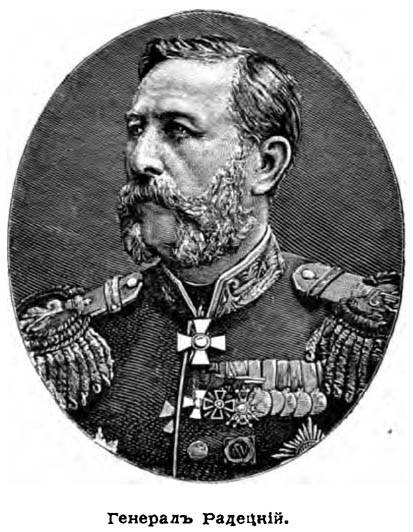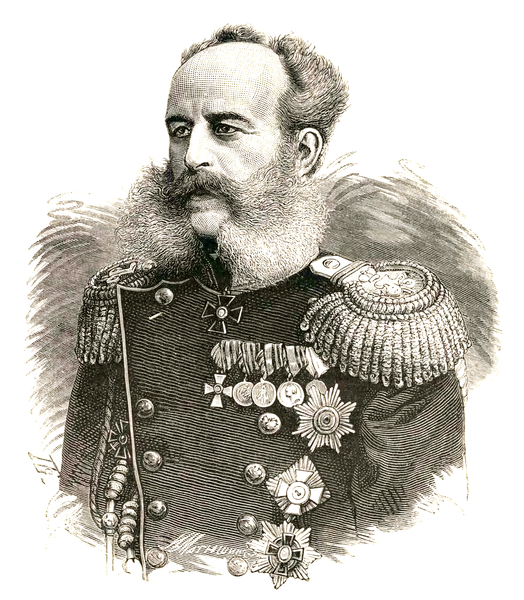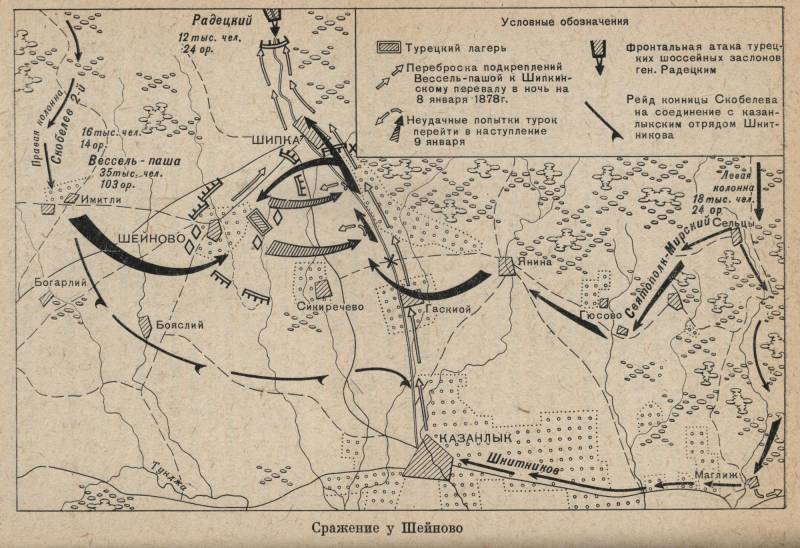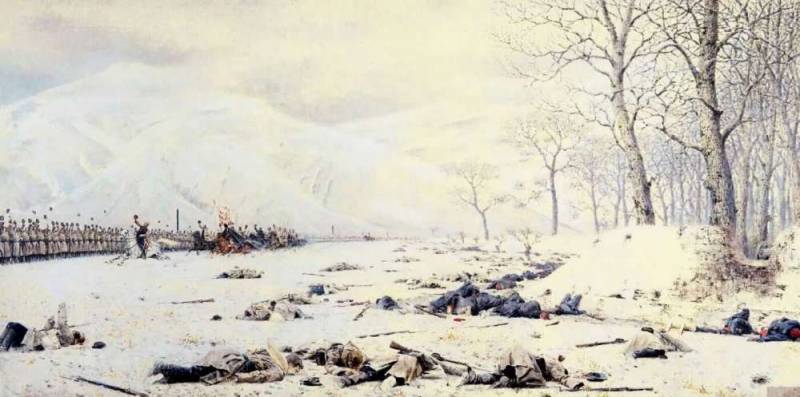Storming the Shipko-Sheynovsky positions of the Turkish army
Forces of the parties. Preparation of the operation
The passage through the Balkans of the Western and Troyan detachments opened the way for the start of the offensive of the FF Radetsky detachment. Shipka direction was defended by the selective Turkish army of Wessel Pasha, numbering 35 thousand people with 103 guns. The advanced positions of the Turkish troops were located north of the village of Shipka, and the main forces were located in the fortified camp of Sheinovo. Directly in the area of Shipka-Sheinovo the Turks had more than 23 thousand people and 83 guns.
The fortifications that encircled Sheinovo from all sides within a radius of about 1,5 km consisted of 114 redoubts and trenches. In addition, numerous burial mounds located near Sheinovo Grove were prepared for defense. The eastern end of the camp was the most strongly fortified in 2 km, where there were two lines of fortifications: in the first line there were five mounds, fortified with trenches in several tiers, in the second - five redoubts with intermediate trenches. Almost beyond the center of the second line, somewhat closer to the village of Shipka, was the largest mound of Kosmatka with a strong battery - Wessel Pasha himself was there with his headquarters and reserve. The left flank of the eastern face adjoined Shipka, the right flank rested on the forest at Sikirichevo. In front of the entire eastern face of the fortified camp, the terrain was flat as a table and covered with deep snow.
The central detachment of Radetzky occupied the Shipka and neighboring passes. Radetzky's troops were significantly strengthened before the start of the operation. The 16 Infantry Division, the 3 battalion of the 3 Infantry Brigade, the 4 th Sapper Battalion and the 9 Cossack Regiment were sent to Radetzky. They replaced the bloodless 24 Infantry Division, relegated to the rear. Then another 30 Infantry Division and three regiments of the 1 Cavalry Division were sent. As a result, Shipykinskaya group had 53,8 thousand people and 83 guns.
Radetzky regarded the offensive against Turkish positions negatively, regarding him as completely impossible. A walk around the mountains in the winter was also considered by the general at least risky. Therefore, having received an order to launch an offensive, Radetsky asked the commander-in-chief to postpone the attack until Gurko’s troops broke through the mountains, which would force the Turks to clear their positions without a fight. But since Gurko was in a considerable distance and could not provide speedy assistance to Radetsky, the Grand Duke Nikolai Nikolayevich ordered the movement to begin. In addition, the main apartment (headquarters) underestimated the forces of the army of Wessel Pasha. In turn, Radetzky overestimated the capabilities of the enemy and was overly cautious.
As a result, Radetsky had to start preparing the assault on enemy positions. At the same time he demanded new reinforcements. Nikolai Nikolayevich apparently agreed with the arguments of Radetsky, since December 25 1877 (January 6, 1878) moved the Grenadier Corps to Gabrovo. The Grenadiers, without being part of the Shipka unit, made up a sort of reserve for the Radetzky troops and could support them if necessary.
The idea of Radetzky was to part the main forces with the frontal offensive to constrain the main forces of the Turkish army in their positions, and to cover and defeat the main forces from both flanks. To solve this problem, three columns were formed - the middle and two bypass. The 16 right-handed column with thousands of people with 14 guns under the command of Lieutenant-General MD Skobelev had to cross the mountains through the Imitli Pass and by the end of 26 in December 1877 (7 in January 1878) to concentrate in Imitli. It is composed of 16-infantry division, infantry battalion 3 3-brigade, regiments 1-th Cavalry Division, 2 sapper company, the Bulgarian militia squads, 9-th Don Cossack regiment, Ural hundred, one mountain and one field battery.
A left column of about 19 thousand people, with 24 guns under the command of Lieutenant-General N. I. Svyatopolk-Mirsky, was to overcome the Balkans through the Travnensky Pass and concentrate in Gyusovo by the end of December 26. It consisted of the 9 Infantry Division without the Bryansk Regiment, the 4 Infantry Brigade, the 30 Infantry Division, the 23 Don Cossack Regiment, one engineer company, a Bulgarian squad, one mountain and two field batteries. Since the route through the Travneni Pass (35 kilometers) was longer than the route through Imitli Pass (20 kilometers), the entry of Svyatopolk-Mirsky troops was scheduled for the morning of December 24 1877 (January 5 1878), and Skobelev - in the middle of it of the day With the exit of the bypass columns in the designated areas, they had to simultaneously attack opponents from the flanks and cut off the escape routes to the south.
The middle column, numbering about 12 thousand people with 24 guns under the personal command of Lieutenant-General F. Radetsky, remained in the Shipka position and had the task to forge the main forces of Wessel Pasha from the front. It consisted of 14 Infantry Division, Bryansk Regiment and 2 engineering companies. Behind the Radetzky column was a general reserve.

General Fedor Fedorovich Radetsky (1820 - 1890)

Nikolay Ivanovich Svyatopolk-Mirsky's engraving (1833 - 1898)) according to Borel's drawing
Offensive
First at dawn 24 December 1877 g. (5 January 1878 g.) Left column began to move. Troops moved slowly. The path had to be laid in deep snow. Reaching the village of Seltsy, the column turned to the south-west and occupied Gyusovo, and then Yanina. A small Turkish squadron in the area retreated to Sheinovo after a short resistance. Meanwhile, the flank detachment of General Shnitnikov, set aside by Mirsky to cover the main forces from the south, drove the enemy out of Maglizh. Thus, the left column crossed the Balkans at the appointed time.
The path of Skobelev's right column turned out to be more complicated. Her avant-garde entered 17 on 24 on December 1877 (January 5 on 1878). At dawn on December 25, the main forces began their march. The detachment consisted of three brigades of the Bulgarian militia. General Skobelev addressed the soldiers with an appeal: “We have a difficult feat worthy of the tested glory of the Russian flags: today we will begin to cross the Balkans with artillery without roads, making our way in the enemy’s mind through deep snow drifts”.
The path was very difficult. “It’s hard to imagine,” it was noted in the military journal of the 63 Infantry Regiment of the Uglich regiment, “the possibility of moving in mountainous terrain without roads, falling waist-deep in the snow, falling at every step, and at the same time going not freely but loaded and dragging on hands gravity in the form of mountain artillery ". Skobelev also wrote about this: “Not to mention the fact that it was impossible to move other than one at a time, people at every turn fell into deep snow, but sometimes it was so slippery that you had to climb steep stony rises, often taking a step forward in order to roll back step two ... ". As a result, due to the great difficulty of the path, the Scobelev's right column moved more slowly than the left column. Only by the end of December 27 1877 (January 8 1878) did our troops reach Imitli, that is, one day late.
As a result, our troops could not simultaneously attack Sheinovsky fortified enemy camp - December 27, as envisaged by the plan of the operation. Only the column of Svyatopolk-Mirsky was able to launch an offensive in time, Skobelev's troops were only concentrated in Imitli and could not attack. More precisely, Skobelev did not want to attack by the forces that already approached, exaggerating the forces of the enemy and fearing to be surrounded. As Skobelev noted in his report, he found it impossible to attack on Shanevo that day: “1) due to the late time of the day, 2) due to the need to gain a foothold in the occupied position and, finally, 3) the main thing is because of the need to concentrate my forces, because of your Excellency (Radetzky), I received a personal order not to begin the battle, without gathering the whole detachment. ”
December 25 (January 6) The Turks discovered a roundabout movement of Russian troops, there was a threat of encirclement. Wessel Pasha asked Commander-in-Chief Suleiman Pasha what to do. He hoped to get permission to withdraw, but the retreat of the Wessel Pasha group was not included in the calculations of Suleiman Pasha. While Wessel Pasha was at Shipka, he covered the withdrawal of Turkish troops from Philippopol to Adrianople. If Wessel Pasha had departed from Shipka, then the Radetzky detachment could have cut off the path of Suleiman Pasha’s retreat to Adrianople. Therefore, December 26 (January 7) Suleiman ordered to hold the position and at the same time take steps to maintain the possibility of withdrawal. The main forces he located on the crossing positions, and the rest in the fortified camp.
Assault
on December 27rd. The offensive of the troops of Svyatopolk-Mirsky 27 December developed at first successfully. Russian soldiers went to the eastern front of the enemy fortifications under Sheinovo and launched an attack. In 12 hour. 30 min. The first line of Turkish fortifications (mounds with trenches) was occupied. At the same time, three steel tools were captured, the calculations of which were chained to the guns. However, soon after these successes, the advance of the troops of the left column stopped. From the redoubts of the second line, Turkish troops opened heavy gunfire. In an effort to keep the camp, Turkish troops went to the counter. The Turks directed their main blow against the right flank of the Russian detachment. When the enemy came to close range, the Russians opened heavy fire, and then resolutely went forward and threw the enemy.
Having received reinforcements our troops in 14 hour. attacked the redoubts of the second line, but were repulsed. The Turks pulled up reserves to the center and left flank of the eastern front of their fortified camp and again went to the counter. The Russian right flank began to succumb, but the approach of six battalions of sevtsev and orlovtsev from the general reserve gave the opportunity to reflect the Turkish counterattack. True, the troops of the left column suffered during the battle so serious losses and were so exhausted that they could not again go into a general attack. Only three battalions of Yaroslavl remained in the reserve, the cartridges were running out, the noise of the battle from the right-wing column of Skobelev was not heard. Under these conditions, Svyatopolk-Mirsky decided to refrain from further attacks. In addition, the prisoners reported that on the approach of 10-thousand. Corps of Turkish troops, which embarrassed Mirsky. From the south, the main forces of Mirsky were covered by the Shnitnikov detachment, which moved from Maglizh to Kazanlak. Around 14 hours they occupied the northeastern part of Sikirechevo.
At night, the Turks gathered the main forces against the left Russian column. Wessel Pasha took down four battalions from mountain cross-over positions and concentrated almost all of his troops in the Sheinovsky camp in the eastern redoubts, having decided to throw off the left column in a counter-attack in the morning. Wessel Pasha proceeded from the fact that the right-wing column of the Russian 27 December was inactive and that the main threat to him was the troops of Mirsky.
The position of the Svyatopolk-Mirsky detachment was difficult. Parts of the first line were located in 500 - 1000 steps from the Turkish fortifications and occupied a position stretching along the front about 4 km. During the day of the battle, the losses of the first-line battalions reached 1600 people. In addition, over 3, thousands of people left the battle lines to manually treat the wounded to Janina, located in the rear of the position at a distance of 6 km from it. Therefore, the order of the detachment thinned out. In the morning the soldiers did not eat anything and were very tired. The cartridges in the first-line battalions were running out. Nothing was known about the actions of the right column. Mirskiy gathered a military council in the evening and put the question on him - should we not go to Gyusovo at night, strengthen there and wait there either for the arrival of reinforcements from Radetsky, or the approach of Skobelev's column. The Colonel Svishchevsky, the commander of the 5 th sapper battalion, spoke out strongly against it. He said that the withdrawal to Gyusovo was completely unnecessary, and that he was taken overnight to strengthen the occupied positions so that they would not be afraid of any Turkish counterattacks. Svishchevsky’s proposal met with the approval of other council members and was accepted by Svyatopolk-Mirsky. It was decided to strengthen the occupied positions and stubbornly defend them.
Fortifications were built all night. The engineers, who were in charge of their construction, showed ingenuity in the difficult conditions of the exhaustion of the troops, the lack of entrenching tools and deeply frozen ground. Various local objects were adapted to defense, the occupied Turkish positions were converted from improvised materials: stones, snow, broken carts, boughs, manure, taken from killed overcoats, and even horse and human corpses. The fortifications were mutually flanked and were well disguised.
on December 28rd. All these events showed themselves well in the battle that began soon. On the morning of December 28 (January 9), the Turkish guns opened fire on 20, and an hour later the Turkish troops launched a counterattack on the Russian right flank. At the same time, the Turks did not notice the new Russian fortifications, and suddenly they came under fire directed at them from close range. They had to quickly move away, suffering heavy losses.
After a short break, the Turks went on the attack again. The first counterattack was sent to the Russian center, the second to the Russian left flank. Having repulsed the Turkish counterattacks, the Russian troops went over to the pursuit and, on the shoulders of the fleeing Turks, broke into the forest at Sikirichevo, as well as the redoubt closest to the forest. At the same time, on the right flank, the troops of the left column to the 11 hour. captured D. Shipka and the nearest redoubt to it. Thus, both flank of the eastern front of the Sheinovsky fortified camp were captured by the Mir forces.
The introduction of new forces could complete the rout of the enemy, but the five Shnitnikov battalions were stationed at Kazanlak, and Svyatopolk-Mirsky did not dare enter the three battalions remaining in the general reserve. Worldly until the last moment did not believe in victory, and even wanted to withdraw the troops back to Gyusovo. But the troops had already heard that the noise of the battle - Skobelev’s column was advancing, and noticed that the Turks were dragging their forces to the west, so they simply did not follow the order of their indecisive commander.
Meanwhile, he decided to attack Radetsky. To this he was pushed by the disturbing reports of Mirsky. About 16 hour. On December 27, Svyatopolk-Mirsky sent a report to General Radetsky: “Speaking at Shipka, I ordered the Shnitnikov brigade to make a demonstration at Kazanlak from Maglizh, which, as a result, was busy with us without a shot. It turns out that there have been ten thousand arrivals from Yeni-Zagry since yesterday. By this, my situation is still deteriorating, nevertheless, I decided not to retreat from Shipka, so as not to upset the overall plan of action. ” In another report, Svyatopolk-Mirsky wrote: “They fought all day, attacked Shipka, but no one supported it. Large losses, it is impossible to retreat, to decide to sleep in front of the Turkish trenches a few hundred steps - the situation is extreme! About General Skobelev know nothing. Get out. There are few patrons and food. ”
Impact 10-th. the Turkish detachment in the column of Mirsky from the east, with the simultaneous pressure of Wessel Pasha’s troops from the west, made the position of the Russian detachment critical. Reinforcements to Mirsky did not have time. It remained only to attack the center head-on Turkish crossing positions. This hampered the troops of Wessel Pasha and they could not hit the left column with all their strength. To storm the impregnable enemy positions went to 12 hours. With seven and a half battalions of the 14 division. It was necessary to attack on an extremely narrow front, in a closed ranks. Calculation of suddenness (fog) was not justified. It was possible to capture only advanced Turkish trenches, after which the frontal attack choked. Russians lost 1500 people.
Skobelev's column was not concentrated by morning. The 1 Cavalry Division, the Suzdal Infantry Regiment and two Bulgarian squads did not even pull up. Despite the incomplete concentration of column troops, Skobelev gave the order to attack. The offensive was conducted without preliminary artillery preparation, since there was almost no artillery. Having built battle formation, the troops of the right column in 10 hour. launched an offensive on the western front of the camp. Two battalions of the first line stormed the advanced Turkish trenches, but then retreated. The Turks counterattacked and fiercely fired from the fortifications located deep inside. In addition, Wessel Pasha was able to transfer troops from the eastern fortifications, the attacks of the Mirsky column were already exhausted.
To strengthen his right flank, Skobelev introduced the Uglitsky regiment into the first line. Our troops stormed the Turkish redoubts, despite the stubborn resistance of the enemy. Around 14 hours squad Skobeleva took the main enemy positions. The right flank of the Skobelev column connected to the left flank of the Svyatopolk-Mirsky column. The detachments jointly pushed the Turks back to Kosmatka mound. The Turkish army was blocked. The Circassians and part of the Turkish regular cavalry with a small number of infantry tried to break through the closed circle of the encirclement, but only a small group of Circassians succeeded.
Considering further resistance senseless, the Turkish command in 15 hour. decided to capitulate. About 23 thousand people with three generals (9 thousand people in the valley and 13 thousand soldiers in mountain positions) surrendered. The Turks lost 1 thousand people killed and wounded. Our troops captured rich trophies, including 83 guns, a large number of guns, shells, ammunition and various stocks. The losses of the Russian troops were very high and amounted to 5 thousand people killed and wounded. The fact of poorly coordinated assault on the strongly fortified positions of the enemy had an effect. In the left column, the number of losses amounted to over 2 thousand people. In the right column, the number of dead and wounded exceeded 1500 people. Center troops have lost 1500 people.
The Shipko-Sheinovo battle was an outstanding example of a two-way round and the encirclement of a large group of enemies who defended themselves in a well-equipped and strong position. Under Shane, the Turks lost the second of their two best field armies (the first was destroyed and captured at Pleven). Another glorious page was inscribed in the Russian military chronicle.
Results
Thus, the Russian army overcame the Balkan Mountains - the most important defensive line of the enemy. The front of the Turkish army in the left flank and in the center collapsed. The Shakira Pasha and Wessel Pasha groups were crushed and captured. All the remaining Turkish troops that occupied the aisles in the Balkans, hastily retreated to Adrianople, as did the corps, hurrying to strengthen Wessel's army. The link between the Suleiman Pasha group of forces and the East Danube army was interrupted and they were doomed to isolated resistance. The Russian army opened its way to Adrianople and Constantinople.
Shipka-Sheinovo. Skobelev under Shipka. 1878. Vereshchagin V.P.
- Alexander Samsonov
- War 1877-1878 years.
"Constantinople must be ours ..." 140 years ago, Russia declared war on Turkey
"Turkey must cease to exist"
How England battled Russia with Austria-Hungary and Turkey
How Russia saved Serbia from defeat
Russian army on the eve of the war with Turkey
Russian Black Sea Fleet on the eve of the war with Turkey
Turkish Armed Forces
“Only on the shores of the Bosporus can the Turks dominate their way ...”
Turkish command was going to arrange the Russian army "Balkan Cannes"
How England in 1877 year tried to repeat the "Crimean scenario" to defeat Russia
Speech by Montenegro on the Russian side distracted a large grouping of the Turkish army
Battle of the Danube
Battle of the Danube. H. 2
Sturm Ardahan
Dramdag and Dayarskoy battles. The failure of the Russian army at Zivin
140 years of heroic defense of Bayazet
As the plan collapsed "Russian Blitzkrieg" in the Balkans
Breakthrough detachment Gurko in Zabalkanie
How "Leo Pleven" gave the Russian army a bloody lesson
Transition of the Danube army to strategic defense
140 years of the heroic defense of Shipka
“We will stand to the last, we will lay down our bones, but we will not give up our positions”
"On Shipka, everything is calm ..."
The defeat of the Turkish army at Lovce
As Skobelev almost took Pleven
The brilliant victory of the Russian army in the Battle of Avliyar-Aladzhinskom
Kars Night Storm
The defeat of the Turkish army Osman Pasha and the fall of Pleven
Breakthrough of the Russian army through the Balkan Range
"Russian troops passed here and resurrected the glory of Suvorov and Rumyantsev miraculous heroes"


Information